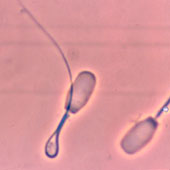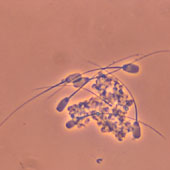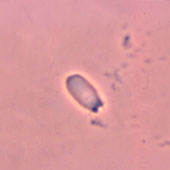To allow an immediate diagnose of the fertility degree of the ejaculate, different techniques for seminal check developed at laboratories can be used.
The perfect test needs to guarantee the following conditions: quickness, objectivity, easiness and accuracy. It is impossible to collect all this qualities on a single technique.
That’s why support and interpretation in conjunction from various techniques is needed, facilitating a more precise diagnose.
Sánchez et al. (1992) have established a table of combined parameters that allow an ejaculate classification. With this table they have achieved an increase of 63 piglets per 100 breedings.
Semen alteration degree can be very variable and result in very variable repercussions as well. In some cases, it’s possible that only semen quantitative performance is affected and that that dose is perfectly usable. In other cases the spermatozoid or seminal plasma are suffering modifications that are not allowing long conservation periods. Other times, capability for fecundation is affected, resulting in decreased reproductive performance.
The following different seminal pathology states can be distinguished:
• Decrease in ejaculate spermatozoid number, due to volume reduction or decrease on its concentration. When spermatozoids are totally mature and have a good fecundant capability, fertility can be only affected when spermatozoid number per dose doesn’t arrive to a minimum (3 x109 spermatozoids). Rising this concentrations it simply supposes a reduction in the Artificial Insemination Centre performance. The most typical example that courses with this sperm concentration reduction, is the situation where number of recollections are increased, lending to an immediate volume and concentration decrease. (Levis, 1986).It has been demonstrated that inseminations that are realized with spermatozoids on a different maturity degree, determine different embryonic developments and viability that induce embryonic mortality and its consequent litter size reduction.
• Spermatozoid alteration that enables fecundation and could affect the ejaculate totally or partially, resulting in gestation mistakes with an increase of returns to oestrus at 21± 2 days. In this case, spermatozoids can have an immaturity degree (morphologic spermatic abnormalities) or the spermatic cell can suffer damage on its cellular structure (plasmatic membrane, acrosome, development of agglutinations or precipitates, motility inhibition) due to seminal plasma alterations or extrinsic aggressions during manipulation at the insemination laboratory.
 |
 |
 |
| Spermatozoid with whip tail | Spermatozoid without tail | Spermatic agglutination |
The use of microscopic or other kind of techniques (Table 1) to evaluate and classify the ejaculates destined to seminal dose preparation, are essential to reach good fertility results. On the investigation field, projects using fluorocromes that allow the realization of very precise and objective studies about the state of different cellular spermatic structures (plasmatic membrane, acrosomies, chromatic condensation, intermediate tract state and tail) are every time more frequent.
Very important advances are being achieved as well on the use of informatic programs that allow to analyze microscopic images, allowing to exactly quantify the vision areas where motility, spermatic morphology or spermatozoids tinged with different colorants or fluorocroms are evaluated. The flux citomethers are equipments that despite of his high cost, are every time more used by laboratories working on semen, allowing very exactly spermatic population studies going on from a very high number of cells.
Table 1
Contrasting techniques to evaluate boar semen quality
| Macroscopic | Biochemistry |
| Volume Color |
pH Osmotic pressure Ionic power Acrosine determination ATT (Aspartate Amino Transferase) determination Lipidic peroxidation Membrane phospholipids Different peptides, ions, enzymes determination |
| Microscopic | |
| Motility percentage Movement quality Concentration Morph abnormalities percentage Aglutination degree Resistance trials Osmotic resistance test Term resistant test Conservation test Acrosome integrity Plasmatic membrane integrity Capacitating degree Determination for the condensation degree |
|
| Software image analyze | |
| Motility evaluation Morphologic evaluation |
|
| Biologic trials | |
| Immunologic tests for particular semen antigens Heterologic penetration test Homologous chromatic penetration test |
|
The homologous penetration tests (with slaughter sows oocites) and heterologous (hamster oocites) are tests that require that the spermatozoid is fulfilling all his functions: Cellular integrity, capacitation, penetration and decondensation. Although the very high cost of this tests, they are the ones that give a better approximation of the fecundant capability of the spermatozoid in vivo.




